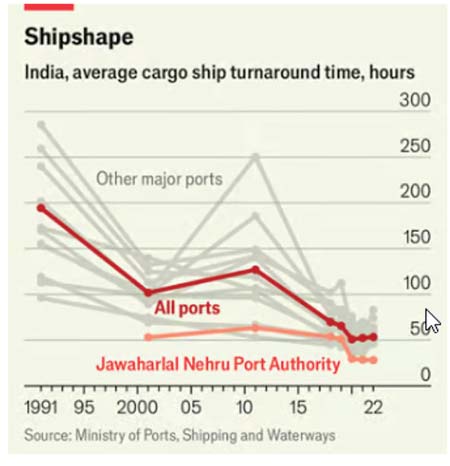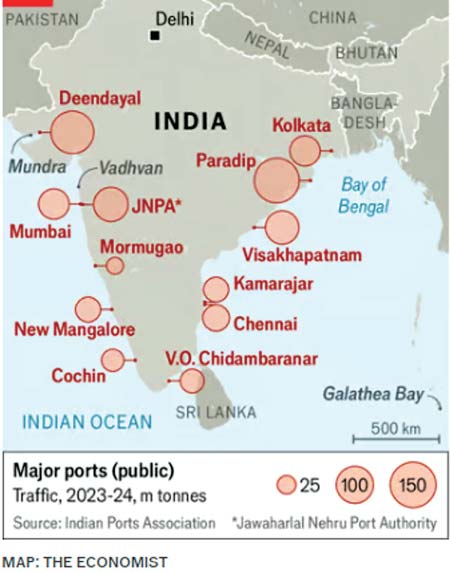Sunday Dec 14, 2025
Sunday Dec 14, 2025
Monday, 27 May 2024 02:04 - - {{hitsCtrl.values.hits}}
 In the narrative of India’s development under Prime Minister Narendra Modi, one achievement stands out: the overhaul of its infrastructure.
In the narrative of India’s development under Prime Minister Narendra Modi, one achievement stands out: the overhaul of its infrastructure.
From extensive motorway networks to bustling urban metro lines, the country has witnessed a remarkable transformation. Yet, amidst these visible advancements, a quieter revolution is underway, reshaping sectors vital to India’s economic future. One such sector experiencing a profound makeover is its ports – crucial gateways to global trade.
Port capacity and efficiency have undergone significant improvements, laying the groundwork for India’s aspirations to become a manufacturing and export powerhouse. With maritime trade accounting for the lion’s share of India’s commerce, the need for world-class ports is paramount. The progress is evident at India’s major ports, where capacity has more than doubled in the past decade, and turnaround times have drastically reduced, catapulting India’s logistics performance to global acclaim.
Take, for instance, Nhava Sheva, nestled across Mumbai’s bustling harbour. The Jawaharlal Nehru Port Authority (JNPA), a modern facility established in 1989, exemplifies India’s port transformation. With turnaround times averaging a mere 21 hours, JNPA stands as a beacon of efficiency, handling half of India’s container traffic with finesse.
 This sea-change in port efficiency owes much to strategic policy interventions. The Government’s decision to involve the private sector in port operations and transition to a “landlord model” has spurred competition and innovation. Private operators like DP World and Maersk now manage container terminals at major ports, raising standards across the board. Additionally, infrastructural upgrades and modernisation of customs processes have streamlined logistics, enhancing India’s competitiveness on the global stage.
This sea-change in port efficiency owes much to strategic policy interventions. The Government’s decision to involve the private sector in port operations and transition to a “landlord model” has spurred competition and innovation. Private operators like DP World and Maersk now manage container terminals at major ports, raising standards across the board. Additionally, infrastructural upgrades and modernisation of customs processes have streamlined logistics, enhancing India’s competitiveness on the global stage.
Despite these strides, India’s maritime industry still lags behind global counterparts. The vision for a maritime hub at Galathea Bay and ambitious plans for port expansion underscore India’s determination to chart a new course. Yet, challenges remain, from connectivity issues to the need for deeper ports to accommodate larger vessels.
However, the significance of these port reforms extends beyond trade facilitation. They symbolise the State’s capacity for deep-rooted reform, often imperceptible to the average citizen. By focusing on infrastructure and regulatory simplification, India’s policymakers demonstrate a commitment to broader economic transformation.
As India continues its journey towards becoming a developed nation by 2047, the success of its port reforms serves as a hopeful beacon. If India can revolutionize its ports, it signals the potential for similar transformations across its economy, ushering in a new era of growth and prosperity for all.